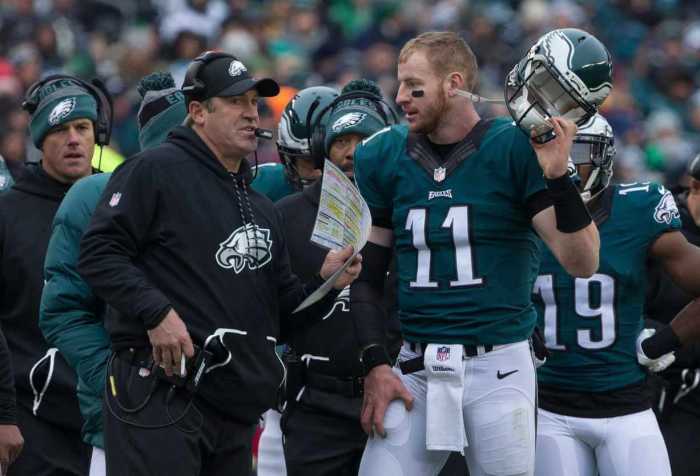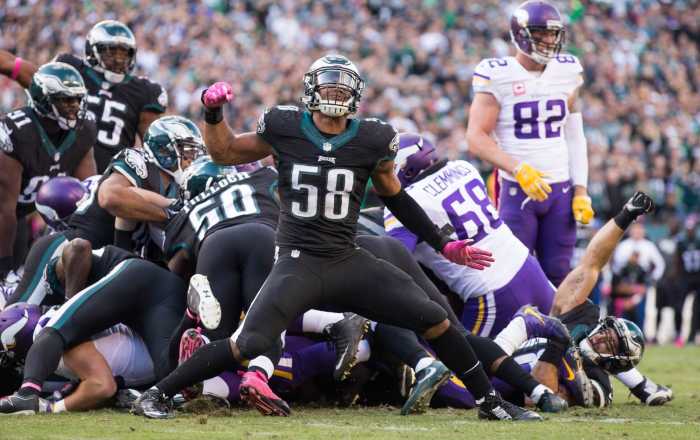While we all get ready to usher in the first full month of summer, we will also be welcoming in a new batch of agonizing football-less months. To ease the pain, this series will be taking a look at the Eagles’ NFC East opponents with true top and bottom line projections: full of arguable and opinion-based forecasts and rife with film study and statistics to back them up. We will dive into position-by-position analysis in an attempt to help you make your own educated decisions on your “buddy’s” favorite team. Continuing with the Dallas Cowboys, today we’ll be taking a look at running backs and offensive lineman. Let’s get started.
Running Backs
It’s difficult to visualize a worst case scenario for arguably the most dangerous rushing attack in football. Last season, despite missing their best play-maker for six games, the Cowboys finished 2nd in rushing with 2,170 yards and tied for 3rd in yards per attempt with 4.5. That is only a slight drop off from the 2016 season, in which they finished 2nd with 2,396 yards and 4.8 yards a carry. With Zeke back in the lineup, and All-Pro talent scattered across the offensive line, expect the ‘Boys to run through the league like they have been. However, as not to be called lazy, let’s poke holes and see what sticks.
| Ezekiel Elliott | Rush Attempts | Yards | Yards/Attempt | Total Touchdowns | Fumbles |
| 2016 (15 Games) | 322 | 1631 | 5.1 | 15 Rush 1 Rec | 5 |
| 2017 (10 Games) | 242 | 983 | 4.1 | 7 Rush 2 Rec | 1 |
Zeke’s 2016 fumble woes were non-existent in 2017. In terms of ball security, the Cowboys were impeccable, registering only one fumble lost all season. Elliot is even good in pass coverage, which isn’t always the case with star running backs. The only cause for concern, albeit negligible, is the full yard drop in yards per attempt. While Zeke would often face a stacked box in his rookie year, clearly opposing teams did more to stop him last year. Elliott is a very capable running back in all facets of the game, but where he really thrives is in his ability to exploit cutback lanes against over pursuing linebackers. I made a note while watching film that he habitually tries to outrun opposing linebackers, often to no avail. The point being, as defenses transition to using faster “hybrid” linebackers, Zeke will not be able to rely as heavily on his speed. As long as a defense is able to stay disciplined, and not allow Elliott to capitalize on their over pursuit, he is a less effective running back. This isn’t to say that Zeke isn’t plenty capable of running over undersized linebackers, or breaking through arm-tackles, but he is a running back that can be brought down by the first tackler. There have been 7 games in his NFL career in which Elliott has failed to produce upwards of 4 yards a carry. His opponents: 2016 Giants, Redskins, and Ravens; 2017 Broncos, Cardinals, Chiefs, and Eagles. The characteristic that all of these defenses share is fast, athletic linebackers. This hasn’t gone unnoticed by the Dallas front office.
When linebackers stay disciplined, Zeke can’t cut back and it tackled for a small gain.
Queue a trade for fullback Jamize Olawale from Oakland. This is following the loss of former fullback Keith Smith in free agency. Olawale was originally scooped up as an undrafted free agent by the Cowboys in 2012 before signing a contract with the Raiders. He is a converted receiver with deceptive speed (he ran a 4.53 second 40-yard dash in 2012), and should factor into the passing game. At 240 pounds, he is also a very accomplished blocker for his size. Most importantly, with a well-rounded skill set, he allows the offence to be deceptive and creative. The key here is that he is fast enough to keep up with new-age linebackers and big enough to knock them around.
https://www.youtube.com/watch?v=OcV_SjhFfdU
https://twitter.com/MAOlawale16/status/940811511332827136/video/1
Jason Garrett seems plenty pleased taking the game back to the 1960’s and pounding the rock down unwilling opponents’ gullet, so evidenced by the Cowboys selection of Bo Scarbrough in the 2018 draft. While I don’t expect Bo to see much playing time in his rookie season, we could see Zeke come off for 3rd-and-short plays, letting the big Alabama alum rumble for the first. Appearing the larger of the two backs, Scarbrough is essentially the same size as Zeke, but brings a ferocity that may be needed to push for touches. If nothing else, the Cowboys have renewed their vows to a power running game that wasn’t nearly as successful in 2017 as the team had hoped.
Best Case: Easy: 2016 Cowboys 2.0. 2,400 team rushing yards; Zeke running at 5 yards a click. The Cowboys offence is one that hinges desperately on the success of their ability to run the ball. Therefore, with a fruitful ground attack, the rest of the offence flourishes. Elliot shows his ability to consistently turn check down passes and swing routes into meaningful gains. Dak gets his confidence back with the return of his backfield counterpart. Jamize Olawale also gets involved in the passing game. The addition of new O-Line coach Paul Alexander infuses some much needed variation to the run game. Zeke is so efficient that Bo Scarbrough is able to claw his way into the game and make the most of his opportunities off the bench, a-la-Corey Clement. Olawale makes an already commanding run attack that much more difficult to face. Look out!
Worst Case: Elliott’s yards per carry resemble 2017, and possibly decline even further — facing a stacked box with no respect for the Dallas passing game takes a toll. The loss of former O-Line coach Frank Pollack proves to be detrimental, and despite his vast experience, Coach Alexander can’t stop the leaking. Slow your roll though Eagles fans, even in their grim 2017 season the Cowboys still ran for 2170 yards. That was good for second in the league, 55 yards ahead of the Eagles. Importantly, a less able ground game limits the Cowboy’s ability to run play action and allows corners to bite on quick passes, making life even harder for Dak.
Offensive Line
On paper, this is the most talented line in all of football. Even when excessively trying to nit-pick minor faults, this group’s shortcomings are few and far in between. Tyron Smith, by his own standard, had a sub-par 2017 (8 penalties, 3 sacks allowed) and the line still looked the part. The only knock against the All-Pro is that he has only played 13 games in each of the past 2 years, and could very well miss some time in 2018.
This line helped Alfred Morris run for 5.35 yards per carry against the best run defense in football. Sometimes they allow Dak so much time in the pocket he doesn’t know what to do with it. They’re strong, physical, athletic and intelligent. In the run game, nasty strong side blocking often causes linebackers to over-pursue, allowing backside pulls, and huge cutback lanes for Elliot. Dominance in the run game unfairly overshadows some pretty talented pass blockers in Dallas.
Although they had a down season last year, posting middle-of-the-pack numbers, they undoubtedly have the talent to bounce back in 2018. Center Travis Fredrick hasn’t allowed a sack in 2 years. Zack Martin allowed one in 2017, which I’m sure is eating him up this off-season. That single sack happened on one of only 11 pressures Martin allowed on 531 pass block snaps last season. The weak link from last year was La’el Collins, and by all accounts, he looks poised to step up in his second year at right tackle.
That leaves the left guard position. The Cowboys lost last year’s starter Jonathan Cooper to San Francisco in free agency after having a so-so year in Dallas. As we noted in the last article, the Cowboys offence does seem to sputter when there is consistent pressure up the middle. In comes 2018 second round pick Connor Williams. The 6’5″ 296 pounder played tackle for Texas in college, but will play left guard in Dallas. Many of the knocks against him came due to his lack of length and lower body tightness. Both qualms seem to be remedied by his move to guard. It’s hard not to like this pick. He should be an upgrade in pass blocking after allowing only 27 pressures on 932 pass blocking snaps over his college career at Texas. If Williams needs time to learn before starting, the Cowboys have Cameron Fleming, who they went out and signed in the off season. He should be an instant upgrade to their depth. Fleming has been a serviceable starter for the Patriots in his first 4 years in the league and has the versatility to play both guard and tackle. He’s only 25, and could be a key addition that pays dividends for years to come. If nothing else, he figures to be an improvement over Chaz Green, who allowed 6 sacks to Adrian Clayborn against the Falcons in Smith’s absence.
The biggest change along the O-line is the arrival of former Bengals Offensive Line and Assistant Head Coach Paul Alexander. 2017 Offensive Line Coach Frank Pollack takes Alexander’s place in Cincy — funny how these things work out. The longest tenured offensive line coach (23 seasons in Cincinnati) has worked with the likes of Andrew Whitworth and Willie Anderson. Alexander is a “player” coach and adapts his concepts to work with the talent he has. Over 23 seasons the Bengals have employed various types of running backs and offensive lineman, requiring an adaptable playbook. Therefore, he has the ability to teach and implement as many schemes as his lineman are able to pick up. This could be a perfect fit for the group of very intelligent lineman in Arlington.
Best Case: Best offensive line in football. Sorry Eagles fans. The addition of Coach Alexander adds some spice to an already formidable rushing attack. The ‘Boys are able to play chess games with opposing defensive lines and expose gaping cut back lanes at will. Alexander should help shore up the pass blocking along the line as well. Making Andy Dalton look like a Pro Bowl QB for multiple years in Cincinnati should add a star to any coach’s resume.
Worst Case: A top 5 offensive line in football. The transition from Pollack to Alexander doesn’t go as smoothly as anticipated, but the star-power along the front line is too much to overlook. Injuries may play a factor, but the front office did a fantastic job stocking their shelves with talented and versatile backups. There is a possibility Connor Williams doesn’t catch on as quickly as expected, to add a negative spin on an ultimately positive projection. Even looking past 2018, the Cowboys offensive front looks solid: Tyrone Smith and Travis Fredrick are signed through 2023; Zack Martin is signed through 2024; Connor Williams is signed through 2021, and La’el Collins through 2019. If there is a drop-off in the near future, it figures to be a minor one.
Mandatory Credit: Bill Streicher-USA TODAY Sports




























